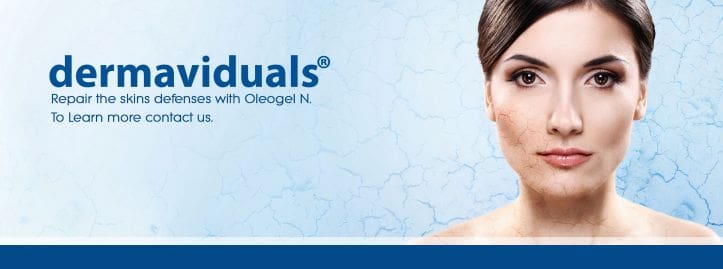
The Epidemic of Skin Barrier Disorders
Skin barrier disorders are a real modern-day challenge for the skin care professional.
A weakened barrier defense system will cause inflammation and influence the innate and adaptive immune systems.
The disordered skin does not always show obvious outward signs of reduced barrier defense. However, there are some diagnostic clues that could help determine if the skin is susceptible to the outside influences that may cause the skin to become inflamed.
These diagnostic clues are; cracked and dry lips, low lipid levels or readings on diagnostic equipment, minimum sebaceous secretions, essential fatty acid deficiency, ageing cells, menopause, flaking dry patches, psoriasis, keratosis pilaris, atopic dermatitis, arthritis and general skin allergies.
Clients that present with skin conditions that indicate the skin barrier defense systems have failed may have medical and cosmetic histories such as asthma, atopic dermatitis, psoriasis, rheumatoid arthritis and allergies.
Modern day lifestyle choices coupled with modern day environmental stressors make for a perfect storm to tip these skin types of skin, with a tendency to barrier disorders, into a reactive state.
That is because corneocytes are the first cells that contact the environment and have an active role in immune defenses. Corneocytes are also cells of the innate immune system and the dominant cell of host defense.
Those of us practicing the principles of Corneotherapy, relish with delight in the knowledge that if a client presents with this skin condition, it would automatically take precedence. The first step in a treatment plan would be to restore skin barrier function.
It is logical to assume, that if the corneocyte has been damaged, due to lipid peroxidation (usually due to the clients lifestyle choices) or, has a poor quality cell envelope and weakened outer shell (poor corneocyte compaction due to intrinsic and extrinsic factors); it may not be able to protect the interior of the body.
It makes sense when we take just one moment to reflect and think what the purpose of the skin barrier is. Yes, to keep allergens and pathogens OUT and keep necessary nutrients, lipids, and moisture IN.
One of the first diagnostic clues I see, when treating skin following the corneotherapy methodology is a rapid decrease in inflammation. That’s followed by an improvement of corneocyte compaction, resulting in a stronger skin barrier that is no longer dry, itchy, cracked or chapped.
Skin that is compromised to the greatest extent is particularly difficult to treat, as they are non-responsive due to weak cell membranes and an already stimulated immune system. Clients complain that their skin react to everything, and logical steps must be taken to repair the skin barrier. The balance of the multilamellar lipids and natural moisture factor must be restored. In this case lipids trump moisture as an Essential Fatty Acid Deficiency (EFAD) will increase Trans Epidermal Water Loss (TEWL) as a result. TEWL in itself can be an aggravating factor. Treatment should happen with as little tissue disturbance as possible as the skin is already in an inflammatory state and often even uncomfortable to the touch.
Where to start?
Products that mimic the multilamellar structure of the skin are ideal. Since the substances are already part of the skin barrier, there is an existing affinity and the skin easily accepts these substances are they are not foreign. Instead, they contain physiological lipids that mirror the ceramides, phospholipids, and essential fatty acid lipid component of the skin.
Immediate protection is necessary for skin with barrier disorders, so applying a ‘barrier’ without occluding is ideal. A ‘breathable’ barrier if you will.
Some ingredients that are physiologically compatible lipids are: Caprylic/Capric Triglyceride, Butyrospermum Parkii Butter, Glyceryl Undecylenate, Oenothera Biennis Oil, Candelilla Cera, Cera Alba, and Lecithin.
The beauty of these products is not only that they are physiologically compatible, rich in essential fatty acids, and prevents inflammatory skin reactions; but they can be beneficial to any skin a wound healing state, such as cracked or chapped skin. We call this mechanism moist wound healing, meaning that the healing occurs from the bottom to the top.
It lends itself perfectly when tissue manipulation is not allowed due to the thixotropic property by which the products spreads very easily when in contact with the skin. Body temperature in essence ‘melts’ the product into the skin allowing for the combination of fatty oils in gel-like consistency nongreasy to the touch.
The ‘breathable’ barrier cream that is beneficial in low humidity and is a corrective skin treatment cream, not a cosmetic cream. Even very small amounts equate in great results.
Oleogel N with evening primrose oil, phosphatidylcholine, beeswax and parki butter, is now available throughout North America. We anticipate this product to be a hot item for skin that is already compromised or find itself in environmental situations that can lead to compromised skin. The wind, the sun, and snow are some examples.
Written by: René Serbon
To learn more, please don’t hesitate to contact us
info@dermalsystems.com | T: 1-855-433-7625 |www.dermalsystems.com

